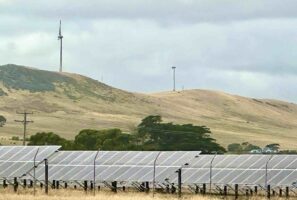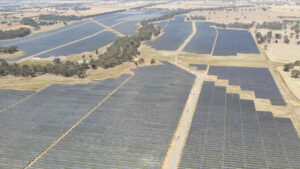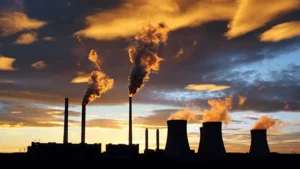In a dramatic U-turn, Sri Lanka’s energy regulator has approved a new long-term electricity supply plan that rejects the construction of any new coal plants between now and 2037.
Coal power’s fall from grace in Sri Lanka has in large part been driven by public opposition to pollution from the country’s only coal plant, the Chinese-funded and built coal-fired Norochcholai Power Station.
The US$1.35 billion plant, which had survived a legal challenge from environmental groups and was commissioned in late 2014, has been chronically unreliable with one or more of the plant’s three 300 megawatt (MW) units often offline and a long-running controversy over the coal supply contract for the plant.
With the domestic credibility of coal in tatters, the spectacular fall in the costs of both wind and solar power – along with low global gas prices – has made a switch to non-coal projects financially and politically attractive.
Early coal plans
In its previous plan, for the 2015 to 2034 period, the coal bias of the Ceylon Electricity Board (CEB) was evident. In its base case CEB pitched for the construction of 11 new coal units with a combined capacity of 3200 MW by 2034. (p. 21)
Even though renewables were booming in India, by 2015 Sri Lanka has done little to emulate the pro-renewables policies of its near neighbour. At the time there was just 1.4 megawatts (MW) of installed solar capacity and 124 MW of wind capacity in the entire country.
While many countries were announcing new renewables targets on a scale of tens of gigawatts or more, CEB proposed base case was timid: it estimated just 225 MW more solar and an extra 595 MW of wind would be built by 2034.
The Public Utilities Commission of Sri Lanka (PUCSL), the energy regulator tasked with reviewing the CEB’s long-term energy generation plans, quibbled with the magnitude of the proposed coal plant boom, paring it back to eight new units with a combined capacity of 2300 MW.
In mid-September 2016, after CEB accommodated modifications suggested by PUCSL, the regulator approved the plan.
Coal plant down
As with all long-term energy generation plans, what matters most are the immediate new projects slated for construction.
The first new plant off the coal rank was supposed to be 500 MW Sampur coal plant at Trincomalee which was backed by NTPC, the Indian Government’s publicly-owned generation utility. (The proposed plant was in large part the offspring of regional geopolitical jostling for influence between China and India: the approval of the Chinese-back Norochcholai Power Station helped galvanise India’s interest in the Sampur coal plant.)
The Sri Lankan Government had granted environmental approval for the project in early 2016, vowing construction work would begin within months. The Minister for Power, Ranjith Siyambalapitiya, proclaimed “we obtained the consent from the environmental organizations and even from villagers.”
The reality though was of strong community opposition to the project. A visit by Sampur residents to see the Norochcholai plant first hand only reinforced their concerns.
As opposition to the project mounted, even the Director General of Sri Lanka’s Petroleum Resources Development Secretariat, Saliya Wickramasuriya, suggested the economic case for switching the project to run on gas was strong.
Besides, he said, having a coal plant on both the east and the west coasts of the country would only ensure particulate fallout over the centre of the island all year round.
According to the CEB, the Sampur plant’s two 250 MW units were slated to be commissioned in 2021 and 2022. It wasn’t to be.
By May 2016 the Sri Lankan Government was willing to drop the coal plan, if it could persuade the Indian Government to support switching it to run on Liquid Natural Gas (LNG).
With India initially reluctant to concede ground on coal, the project was still nominally all set to go.
However, the final blow came in mid-September when a legal action by environmentalists was set to be heard before the Supreme Court. The Ministry of Power and Energy conceded defeat and informed the court the coal plant plan had been dropped.
Subsequently the Indian Government conceded the point on coal and agreed to back a gas plant instead.
The Sampur decision was to prove a major turning point in shifting Sri Lanka away from coal.
Coal’s costs force a rethink
While the PUCSL was broadly on board with the CEB’s coal-centric vision beyond 2022, the regulator could see the dramatic changes sweeping through global electricity markets and with renewables in particular.
For the CEB’s next long-term power plan, to cover the 2018 to 2037 period, PUCSL flagged it wanted to see more detailed assessment of other power supply options.
In particular, the energy regulator wanted CEB to internalise “the environmental, health and other externalities” of burning fossil fuels.
When in late 2016 CEB released its draft of the next plan, it was apparent the utility had learnt little from the rejection of the Sampur plant.
Of the over 8300 MW of new power generation capacity it proposed as being needed over the next 20 years, CEB claimed (p. 22) another seven coal units with a total capacity of 3000 MW would be needed. It also proposed a raft of new gas plants, in part because of potential production from nearby offshore gasfields.
Fossil fuel projects weren’t getting it all their way though.
Unlike its 2015 plan, wind and solar were slated to grow. There was also a raft of large-scale hydro, mini-hydro projects and a few biomass plants in the mix as well.
This time though the proposed coal plants faced tougher scrutiny in the race to be selected among the least cost energy supply options.
PUCSL wanted CEB to calculate the energy costs of coal by explicitly adding an additional of three US cents per kilowatt hour towards the external environmental and social costs of pollution.
It also put the CEB’s proposed plan out for public comment in early 2017. About three dozen comments came in, with some flagging the incompatibility of proposed coal plants with the country’s Paris Agreement obligations.
Others pointed out the inadequate assessment of the implications of the latest renewables costs. There were few submissions championing coal.
In late June 2017 the regulator wanted the CEB to go back to the drawing board and come up with another 12 generation scenarios, half of which were to exclude coal power altogether.
Others were to include more recent fuel prices to allow a more accurate comparison between oil, gas and coal generation options. In its final decision the regulator noted (p. 6) the CEB had low-balled the coal fuel price. The:
“CEB coal price (FOB) assumption is clearly below the current price levels, as opposed to LNG, where CEB price is higher than the current price level. When comparing with the three year moving average prices for coal, assuming a price well below the moving average price (as proposed by CEB) is not recommended.”
To drive home its point the PUCSL included a chart illustrating how the CEB had skewed the data in favour of coal.

By late July the PUCSL had finished crunching the numbers and opted for 4800 MW of new gas plants, with the next biggest sources being 1389 MW of solar and 1205MW of wind. (There were also far smaller contributions from biomass, oil and hydro projects.)
Coal was shunned altogether.
“With updated fuel prices and cost of externalities under least cost principals [sic] coal power plants were not qualified for the 20-year plan,” the PUCSL stated when the regulator announced the final composition of the generation plan.
Sri Lanka’s shift reflects global trend
In the space of a few years coal has gone from being the big new player in Sri Lanka’s energy landscape to being relegated to a bit-part player which will last only as long as the troubled Norochcholai plant staggers on.
For the global coal lobby, Sri Lanka should have been an exemplar of the bright future for the dirty fuel: a low-income country with high electricity growth rates needing a lot of extra generation capacity with international sponsors willing to subsidise new coal plants.
Instead, Sri Lanka is all set to show new coal plant proposals the door.
A combination of community opposition, an unreliable Chinese plant showing all that could go wrong and the rapidly changing economics of renewables and gas have profoundly reshaped the country’s energy future.
As with most old-style utilities, CEB is reluctant to embrace the shift away from coal towards renewables.
Despite the energy regulator’s rejection of its preferred coal-heavy plan, the CEB has launched a rearguard action claiming the regulator doesn’t have the power to reject its preferred plan. To pacify the CEB the Secretary of the Ministry of Power and Renewable Energy, Dr. B.M.S. Batagoda, has promised he will convene a meeting of CEB and PUCSL officials.
While new gas plants may appear to be the biggest winners, the PUCSL has flagged that when the CEB prepares its next long-term generation plan it will need to do a far better job of assessing the costs of solar and wind generation. Renewables may well see off much of the gas generation expansion flagged in the current plan.
Bob Burton is the Editor of CoalWire, a weekly bulletin on global coal industry developments. (You can sign up for it here.) His Twitter feed is here.











